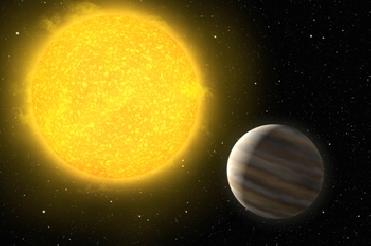
An artist's impression of the new-found planet named OGLE-TR-L9b. Photo credit: ESO
AMSTERDAM (BNS): Three undergraduate students from the Netherlands have unearthed an extraordinary extra-solar planet orbiting a fast-rotating hot star.
The planet, which is about five times as massive as Jupiter, circles its host star every 2.5 days. It lies at only three percent of the Earth-Sun distance from its star, making it very hot and much larger than many other planets.
The students from Leiden University -- Meta de Hoon, Remco van der Burg, and Francis Vuijsje -- were testing a method of investigating the light fluctuations of thousands of stars in the OGLE (Optical Gravitational Lensing Experiment) database in an automated way, when they stumbled upon the find, an ESO release said.
"The brightness of one of the stars was found to decrease for two hours every 2.5 days by about one per cent. Close observations, taken with ESO's Very Large Telescope in Chile, confirmed that this phenomenon was caused by a planet passing in front of the star, blocking part of the starlight at regular intervals," the researchers said.
Speaking about the discovery, supervisor of the research project, Ignas Snellen said it was a complete surprise. "The project was actually meant to teach the students how to develop search algorithms. But they did so well that there was time to test their algorithm on a so far unexplored database. At some point they came and showed me this light curve and I was completely taken aback," Snellen said.
The planet is given the prosaic name OGLE2-TR-L9b. "But amongst ourselves we call it ReMeFra-1, after Remco, Meta, and myself," Francis said. However, Meta said it was exciting not just to find a planet, but to find one as unusual as this one; it turns out to be the first planet discovered around a fast rotating star, and it's also the hottest star found with a planet. "The computer needed more than a thousand hours to do all the calculations," Remco added.
The planet was discovered by looking at the brightness variations of about 15, 700 stars, which had been observed by the OGLE survey once or twice per night for about four years between 1997 and 2000. "Because the data had been made public, they were a good test case for the students' algorithm, who showed that for one of stars observed, OGLE-TR-L9, the variations could be due to a transit — the passage of a planet in front of its star. The team then used the GROND instrument on the 2.2 m telescope at ESO's La Silla Observatory to follow up the observations and find out more about the star and the planet," the supervisor said.
"But to make sure it was a planet and not a brown dwarf or a small star that was causing the brightness variations, we needed to resort to spectroscopy, and for this, we were glad we could use ESO's Very Large Telescope," Snellen said.
"The spectroscopy also showed that the star is pretty hot - almost 7000 degrees, or 1200 degrees hotter than the Sun. It is the hottest star with a planet ever discovered, and it is rotating very fast. The radial velocity method - that was used to discover most extra-solar planets known - is less efficient on stars with these characteristics. This makes this discovery even more interesting," Snellen added.
 Previous Article
Previous Article Next Article
Next Article













The Indian Air Force, in its flight trials evaluation report submitted before the Defence Ministry l..
view articleAn insight into the Medium Multi-Role Combat Aircraft competition...
view articleSky enthusiasts can now spot the International Space Station (ISS) commanded by Indian-American astr..
view article